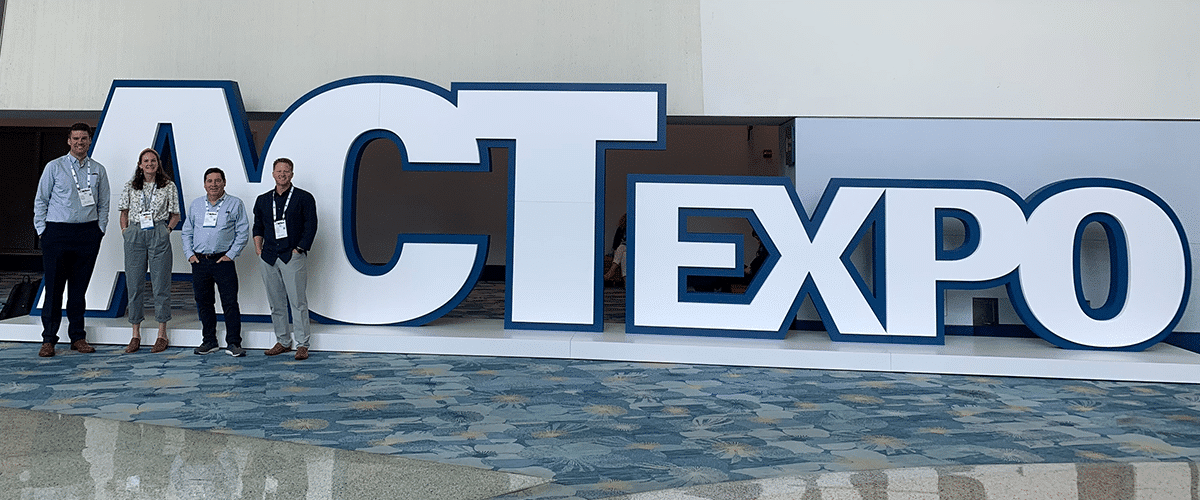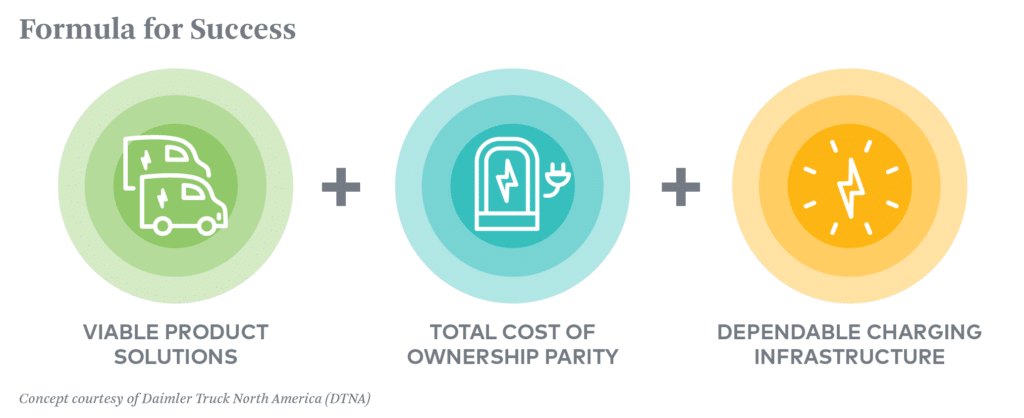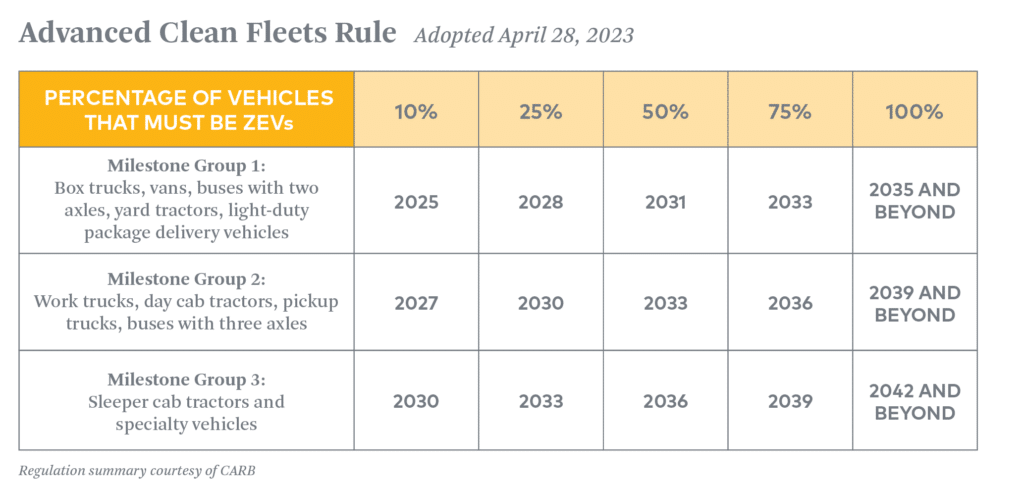Earlier this month, 3Degrees had the opportunity to join other transportation industry players at Advanced Clean Transportation (ACT) Expo, a growing sustainable mobility conference with no signs of slowing down. The transportation transformation is happening right before our eyes, and it’s never felt more real than it did at ACT. Over 10,000 attendees gathered to discuss all facets of sustainable mobility and the momentum was tangible. It was evermore apparent that the transition to electric does not just pertain to passenger vehicles (SUV, Sedans, etc.), but every type of mobility you can think of – both on- and off-road: yard tractors, forklifts, transport refrigeration units, marine – you name it.
Big themes at the conference this year included the infrastructure availability challenge, new zero emissions vehicle (ZEV) policies like the Advanced Clean Fleets rule, hydrogen applications, utility and grid synchronicities, and public-private partnerships. In this blog, I hope to explore a few of these topics as well as share lessons learned from fleet transition discussions our team took part in.
Keys to a robust fleet transition plan
With new technologies emerging constantly, organizations actively working to reduce transportation emissions should have robust transition plans in place with some built-in room for flexibility. At ACT, I noted a few strategies fleets were incorporating to stay flexible as they transition to decarbonized fleets.
Being proactive and forward thinking was a sentiment I heard repeatedly – in order to gain a competitive advantage, stay ahead of the compliance curve, and create a cushion of time for delays or unforeseen logistical hiccups. For example, Bonnie Nixon, Director of ESG and Sustainability at the Long Beach Container Terminal (LBCT) urged that “planning ahead is critical” and that fleets “need to look 3-5 years out.” Nixon also stressed the importance of identifying what is driving an organization’s desire to electrify and that a cost-benefit analysis can be helpful in understanding what is most viable, implementable and affordable.
Leading by example, LBCT shared that the changes they made to their operations allowed them to take advantage of the Warehouse Actions and Investments to Reduce Emissions (WAIRE) program. The WAIRE program is a credit /deficit system related to truck traffic and aims to reduce warehouse emissions, specifically those related to transportation-related activities. LBCT has used this program to generate revenue and offset the cost of its transition.
Two takeaways from this discussion were that there are hundreds of millions of dollars available in grants, incentives and loans to assist with fleet electrification, and when looking at operational costs, an organization should examine warehouse and fleet emissions simultaneously, not in silos. A successful fleet is one that plans properly for regulation impacts, leverages incentive programs, maximizes infrastructure utilization, and develops a multi-phase approach that builds its electrified fleet one piece at a time, knows its total cost of ownership (TCO) analysis process and has fleet replacement cycles in place.
Market Landscape
There are many factors to consider when transitioning to an electric fleet. Like Ari Silkey, Amazon’s General Manager of North America Surface Transportation, said, “Navigating the vehicle availability and infrastructure confluence, balancing the utility requirements, and chasing after funding is a challenging dance to do.” There are an overwhelming number of options to choose from and pathways to take, but companies that focus on their fleet electrification now can avoid non-compliance penalties and exemplify leadership in the space.
I heard at ACT that there are currently over 550 incentive programs to take advantage of, including the numerous regional clean fuel standard (CFS) programs in North America, which can help ensure a positive TCO, amongst other things. Many of the incentive programs can be combined to finance fleet electrification, and multiple programs (including the CA LCFS) even extend subsidies for acquiring infrastructure. This concern of infrastructure availability was touched on in nearly every session I attended. I learned that 30 DC chargers need to open per day from now to 2026 just for California to meet its targets. John O’ Leary, President & CEO of Daimler Truck North America (DTNA), shared a formula for success in transportation decarbonization, which included:
- Viable product solutions
- Total cost of ownership (TCO) parity
- Dependable charging infrastructure
He stressed that infrastructure must be ubiquitous or else the formula doesn’t work. Right now, charging infrastructure is missing and without it DTNA will miss their goals. Throughout ACT week, I picked up on a sense of frustration. “How can our nation’s fleets meet the desired reduction targets if they can’t charge domicile vehicles?” he asked the audience. During his keynote presentation, O’ Leary introduced GreenLane, a project built by DTNA, NextEra Energy Resources and BlackRock Alternatives, that hopes to develop public charging and refueling (EVs and HFCVs) infrastructure depots for medium-duty (MD) and heavy-duty (HD) fleets.
Multi-Solution Sector
In attending sessions at ACT, I began to recognize that fleets are not exclusively picking one solution, but are using different technologies for various use cases. “It is not one size fits all here,” said ChargePoint President & CEO, Pascuale Romano. “There is a place for every fuel type.” For light-duty, EVs are the overarching solution, but for MD and HD fleets, there are many options to weigh — hydrogen fuel cell, CNG, RNG, or electric? Hydrogen has many uses for all applications, and is already being utilized in fleets, such as that owned by Amazon, who already has 70 locations using hydrogen with plans to scale this up. They also have CNG trucks, Rivian EVs and electric yard vehicles in use. Having multi-fuel and multi-make fleets are effective strategies to mitigate labor shortages, supply chain strains, and other causes of order delays.
Kevin Schwalb, VP of Government Relations at Textile Rental Services Association of America (TRSA), said that TRSA has experienced major delays with the ZE trucks they’ve ordered. One purchase order example he mentioned was that 40 trucks could take over three years to arrive. He said that they manage their orders differently now, taking into account that something is likely to be delayed: “it’s whack a mole – totally different every week.” Building in room for those hurdles is a best practice.
As some of the first big electric truck projects are now underway, this issue of manufacturing delays came up in the Executive Infrastructure Roundtable and other sessions at the conference. Many voices stressed the need for production at scale, so the quantities of vehicle and infrastructure equipment supply meet the demand of fleets. Mark Esguerra, Director of Distribution Planning and Strategy at Southern California Edison, urged companies to prioritize permitting and licensing early in anticipation of slow progress on the utility side. I heard that it is vitally important to communicate objectives and deployment plans with your utility, and later engagement can cause delays.
The Zero Emission Era
Adopted in California the Friday before ACT, the Advanced Clean Fleets (ACF) regulation was another major talking point at the conference. Working in conjunction with the previously-adopted Advanced Clean Truck regulation, the ACF aims to speed up the adoption of ZEV technologies in the MD and HD transportation space. The rule goes into effect on November 1 and calls for early reporting / compliance at the end of this year. Starting in 2024, fleets are required to purchase an increasing number of ZEVs.
A pair of regulatory bookends, the Advanced Clean Truck and Fleet rules will affect any organization that touches transportation in the state of California. Over a dozen states have adopted the Advanced Clean Trucks rule, including Washington, which added ZEV sales requirements starting with model year 2025 and will require manufacturers of MD and HD trucks to produce an increasing number of ZEVs for sale in 2024. Many states are also expected to enact their own version of the ACF rule, with California’s program as the model.
Transport Refrigeration Units (TRUs) were a popular topic at ACT this year as well, with a whole session devoted to it on the first day. The California Air Resources Board (CARB) approved amendments to the TRU regulation and requires reporting for all TRUs in operation at the end of 2023, with 15% of a TRU fleet needing to turn over to ZE technology each year from now until the end of 2029. To help finance this piece of the electrification puzzle, credit pathways exist for eTRUs in market-based incentive programs like the LCFS. With the adoption of many new ZEV mandates, having a sturdy regulatory strategy has become even more essential to the success of any organization’s effort to electrify.
Closing Remarks
I heard at ACT that 2024 will be a year of transition for the transportation industry. Leaving the conference, I felt both a great deal of uncertainty around the ability for fleets to manage this transition in conjunction with OEMs, utilities, and financial partners as well as a renewed sense of hope, with the amount of viable solutions and brilliant minds working on this opportunity for a net zero transport sector.
3Degrees has a team of experts that can help your organization build a fleet transition plan that is strengthened by market-based incentive participation, solidified by regulation compliance, and respected by competitors. For more on how to set your fleet up for success, please get in touch.



